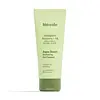What's inside
What's inside
 Key Ingredients
Key Ingredients

 Benefits
Benefits

 Concerns
Concerns

 Ingredients Side-by-side
Ingredients Side-by-side

Water
Skin ConditioningSodium C14-16 Olefin Sulfonate
CleansingSodium Cocoamphoacetate
CleansingCocamide Mea
EmulsifyingCoco-Betaine
CleansingSodium Lauroyl Sarcosinate
CleansingCoco-Glucoside
CleansingDecyl Glucoside
CleansingPEG-150 Distearate
EmulsifyingPanthenol
Skin ConditioningGlycerin
HumectantGluconolactone
Skin ConditioningPhenoxyethanol
PreservativeEthylhexylglycerin
Skin ConditioningParfum
MaskingLactobacillus/Aloe Barbadensis Ferment Filtrate
Skin ConditioningSpinacia Oleracea Leaf Extract
Skin ConditioningCucumis Sativus Extract
Skin ConditioningOcimum Sanctum Leaf Extract
Skin ConditioningAzadirachta Indica Leaf Extract
Skin ConditioningCamellia Sinensis Leaf Extract
AntimicrobialMoringa Oleifera Leaf Extract
Skin ConditioningCoriandrum Sativum Leaf Extract
AntimicrobialMedicago Sativa Extract
TonicLactococcus Ferment Lysate
Skin ConditioningBifida Ferment Lysate
Skin ConditioningCI 75810
Cosmetic ColorantWater, Sodium C14-16 Olefin Sulfonate, Sodium Cocoamphoacetate, Cocamide Mea, Coco-Betaine, Sodium Lauroyl Sarcosinate, Coco-Glucoside, Decyl Glucoside, PEG-150 Distearate, Panthenol, Glycerin, Gluconolactone, Phenoxyethanol, Ethylhexylglycerin, Parfum, Lactobacillus/Aloe Barbadensis Ferment Filtrate, Spinacia Oleracea Leaf Extract, Cucumis Sativus Extract, Ocimum Sanctum Leaf Extract, Azadirachta Indica Leaf Extract, Camellia Sinensis Leaf Extract, Moringa Oleifera Leaf Extract, Coriandrum Sativum Leaf Extract, Medicago Sativa Extract, Lactococcus Ferment Lysate, Bifida Ferment Lysate, CI 75810
Water
Skin ConditioningDisodium Cocoamphodiacetate
CleansingDecyl Glucoside
CleansingGlycerin
HumectantCoco-Glucoside
CleansingCocamidopropyl Hydroxysultaine
CleansingXanthan Gum
EmulsifyingPotassium Sorbate
PreservativeBetaine
HumectantGlyceryl Glucoside
HumectantXylitylglucoside
HumectantTrehalose
HumectantLactic Acid
BufferingAloe Barbadensis Leaf Juice
Skin ConditioningSaccharide Isomerate
HumectantHyaluronic Acid
HumectantSodium Gluconate
Skin ConditioningLavandula Angustifolia Oil
MaskingSodium Hyaluronate
HumectantWater, Disodium Cocoamphodiacetate, Decyl Glucoside, Glycerin, Coco-Glucoside, Cocamidopropyl Hydroxysultaine, Xanthan Gum, Potassium Sorbate, Betaine, Glyceryl Glucoside, Xylitylglucoside, Trehalose, Lactic Acid, Aloe Barbadensis Leaf Juice, Saccharide Isomerate, Hyaluronic Acid, Sodium Gluconate, Lavandula Angustifolia Oil, Sodium Hyaluronate
Ingredients Explained
These ingredients are found in both products.
Ingredients higher up in an ingredient list are typically present in a larger amount.
Coco-Glucoside is a surfactant, or a cleansing ingredient. It is made from glucose and coconut oil.
Surfactants help gather dirt, oil, and other pollutants from your skin to be rinsed away.
This ingredient is considered gentle and non-comedogenic. However, it may still be irritating for some.
Learn more about Coco-GlucosideDecyl Glucoside is a glucose-based surfactant and emulsion stabilizer. It is created by reacting glucose with the fatty acids from plants.
Surfactants help clean the skin by trapping oil, sebum, and dirt to be washed away. As an emulsion stabilizer, it stabilizes the ingredients in a product by preventing them from separating.
This ingredient is biodegradable and non-toxic. This ingredient is commonly found in baby shampoos.
Decyl Glucoside is sometimes used to stabilize the UV filter Tinosorb.
Learn more about Decyl GlucosideGlycerin is already naturally found in your skin. It helps moisturize and protect your skin.
A study from 2016 found glycerin to be more effective as a humectant than AHAs and hyaluronic acid.
As a humectant, it helps the skin stay hydrated by pulling moisture to your skin. The low molecular weight of glycerin allows it to pull moisture into the deeper layers of your skin.
Hydrated skin improves your skin barrier; Your skin barrier helps protect against irritants and bacteria.
Glycerin has also been found to have antimicrobial and antiviral properties. Due to these properties, glycerin is often used in wound and burn treatments.
In cosmetics, glycerin is usually derived from plants such as soybean or palm. However, it can also be sourced from animals, such as tallow or animal fat.
This ingredient is organic, colorless, odorless, and non-toxic.
Glycerin is the name for this ingredient in American English. British English uses Glycerol/Glycerine.
Learn more about GlycerinWater. It's the most common cosmetic ingredient of all. You'll usually see it at the top of ingredient lists, meaning that it makes up the largest part of the product.
So why is it so popular? Water most often acts as a solvent - this means that it helps dissolve other ingredients into the formulation.
You'll also recognize water as that liquid we all need to stay alive. If you see this, drink a glass of water. Stay hydrated!
Learn more about Water